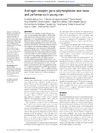Please use this identifier to cite or link to this item:
https://accedacris.ulpgc.es/jspui/handle/10553/6537
| Title: | Androgen receptor gene polymorphisms lean mass and performance in young men | Authors: | Guadalupe-Grau, Amelia Rodriguez-Gonzalez, Francisco Germán Dorado, Cecilia Olmedillas, Hugo Fuentes, Teresa Pérez-Gómez, Jorge Delgado-Guerra, Safira Vicente-Rodríguez, Germán Ara, Ignacio Guerra, Borja Arteaga Ortiz, Rafael Ángel Calbet, Jose A. L. Diaz-Chico, Bonifacio |
UNESCO Clasification: | 2411 Fisiología humana | Keywords: | Testosterone Exercise performance |
Issue Date: | 2011 | Journal: | British Journal of Sports Medicine | Abstract: | The exon-1 of the androgen receptor (AR) gene contains two repeat length polymorphisms which modify either the amount of AR protein inside the cell (GGN(n), polyglycine) or its transcriptional activity (CAG(n), polyglutamine). Shorter CAG and/or GGN repeats provide stronger androgen signalling and vice versa. To test the hypothesis that CAG and GGN repeat AR polymorphisms affect muscle mass and various variables of muscular strength phenotype traits, the length of CAG and GGN repeats was determined by PCR and fragment analysis and confirmed by DNA sequencing of selected samples in 282 men (28.6 +/- 7.6 years). Individuals were grouped as CAG short (CAG(S)) if harbouring repeat lengths of <!--= 21 and CAG long (CAG(L)) if CAG -->21. GGN was considered short (GGN(S)) or long (GGN(L)) if GGN <!--= 23 or -->23, respectively. No significant differences in lean body mass or fitness were observed between the CAG(S) and CAG(L) groups, or between GGN(S) and GGN(L) groups, but a trend for a correlation was found for the GGN repeat and lean mass of the extremities (r=-0.11, p=0.06). In summary, the lengths of CAG and GGN repeat of the AR gene do not appear to influence lean mass or fitness in young men. | URI: | https://accedacris.ulpgc.es/handle/10553/6537 | ISSN: | 0306-3674 | DOI: | 10.1136/bjsm.2009.060285 | Source: | British Journal Of Sports Medicine[ISSN 0306-3674],v. 45 (2), p. 95-100 |
| Appears in Collections: | Artículos |
SCOPUSTM
Citations
18
checked on Jun 8, 2025
WEB OF SCIENCETM
Citations
15
checked on Jun 8, 2025
Page view(s)
95
checked on May 23, 2024
Download(s)
344
checked on May 23, 2024
Google ScholarTM
Check
Altmetric
Share
Export metadata
This item is licensed under a Creative Commons License

